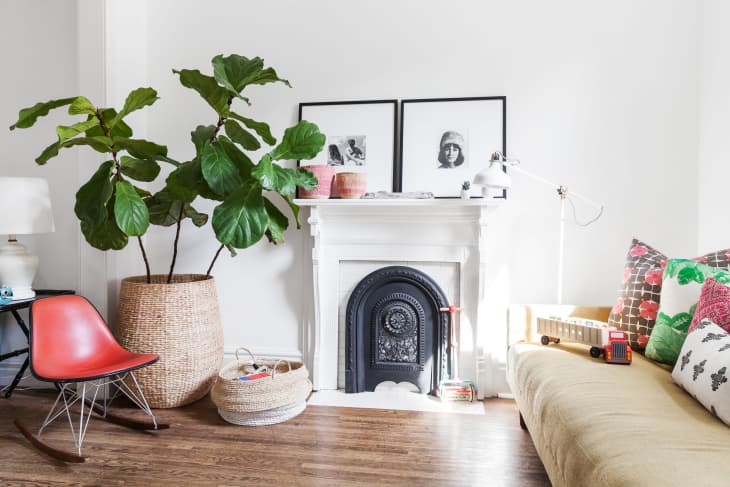How to Keep Your Fiddle Leaf Fig Happy and Healthy

Ah, the fiddle leaf fig, aka ficus lyrata/pandurata. It’s Instagram’s most popular plant, the top choice among many interior designers, and an enticing siren to first-time plant parents. True, they’re not as patient as the equally Instagram-famous rubber plant, but a little extra TLC, enough drainage, good lighting, a quick shake, and attention to detail can make all the difference. to your fiddle leaf fig.
Although these gorgeous flowering plants are native to tropical areas of West Africa, they’ve found a home under many roofs worldwide. Why the funky name? If you’ve been scratching your head as to why it’s called a fig sans any fruit, it’s helpful to know that in the wild, fiddle leaf figs will typically flower and produce fruit, which rarely happens when they’re grown indoors.
Fiddle leaf figs fit nearly any decor style, and whether a faux plant or the real deal, they make for a gorgeous and extravagant statement and a tree-like splash of greenery. While they’re undeniably stunning, they’re not the easiest plants to care for—but with attention, patience, and the right placement, devoted plant parents can make them happy.
If a fiddle leaf fig has found its way into your home, we’ve got plenty of tips and facts for making sure it lives a happy life.
What kind of light and climate does a fiddle leaf fig need?
Although fiddle leaf figs are acclimated to warm, humid environments, that’s not something that can easily be maintained in a home or apartment. Luckily, that’s not a huge dealbreaker for this plant. For your fiddle leaf fig to really thrive, it’ll ideally need the following conditions:
- Bright, filtered light. For example, a window with a sheer curtain that gets direct sunlight is perfect.
- Warmer climate. Fiddle leaf figs don’t do well in the cold and prefer warm, humid environments.
- Soil with good drainage.
- Place away from drafty windows or air vents that are constantly being used.
- Feel like going above and beyond? Place a humidifier near your fiddle leaf to amp up the humidity.
Can a fiddle leaf fig live outdoors?
Yes, it definitely can, but it must be in the right climate. There are a few differing opinions out there, but the hardiness zones usually recommended are zones 10 through 12—the very southernmost of the continental United States and Hawaii. Needless to say, this excludes much of the country.
But during warmer seasons, no matter your hardiness zone, you can give your fiddle leaf a little outdoor time as long as it stays above 50 degrees Fahrenheit but isn’t scorching hot. If you decide to plant your fiddle leaf fig outside, just be aware that it can get tall—we’re talking 50 feet tall—if you let it.
How should I water a fiddle leaf fig? Should I mist it too?
Usually, fiddle leaf figs need room temperature water every eight to 10 days or so. This being said, each plant varies slightly, and purchasing a moisture meter will take the guessing out of determining when to next water your plant. It’s best to err on the side of caution, as they can handle drought much better than accidental overwatering.
Make sure that the pot your fiddle leaf fig lives in has good drainage, but double-check that the surface its planter sits on is protected from any water damage—a cork mat or placing on tile flooring can help with that.
When it comes to misting your plant, a few times a week is usually a good rule of thumb. A very light misting is all it needs to help keep it healthy, as it somewhat mimics the humid environment these plants thrive in.
How do I clean the plant’s leaves?
A light cleaning of a fiddle leaf fig’s leaves can keep the plant healthy and happy. These are a few things to keep in mind in order to properly wipe it down:
- Use a soft cloth to remove any dust. A soft sponge works fine, too.
- Post-dusting, mist the leaves with water to promote humidity.
- You’ll know better than anyone at determining how often to clean your plant’s leaves. If you can wipe the dust off of it, it’s ready for a gentle wash.
- Leave no leaf left unturned. Make sure to gently wipe around the veins, where it’s easier for dust and dirt to accumulate, too.
What should I do if the leaves are turning brown or the plant seems to be dying?
A few dropped leaves are no reason to fret, and it’s worth investigating before getting too worried. Often, a fiddle leaf fig that’s new to a space will need some time to adjust. This can lead to a bit of leaf loss, but as long as you’re caring for the plant, it should pass.
If this is a long-running problem or you’re starting to see brown spots, it’s smart to act quickly in case it’s a fungal issue, such as root rot. Check and see if the plant is overwatered and ensure it’s properly draining. Also, confirm that it’s in a place that gets plenty of light.